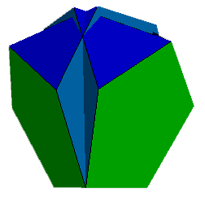
These polyhedra are also presented as 'Stress Maps', a bespoke form of VRML model for showing distortion in such models. More information on Stress Maps and distortion is available here.
This 6-5-3 near miss was discovered by myself in 2005. It was an attempt to solve the 6-5-3 acron by following Mason Green's methodology by which the 7-7-3 acron was solved. The distortion is restricted to the triangular faces. (Stress map). Distortion: (E=0.106, P=0, A=23.3°)
This 6-5-3 near miss was discovered by Roger Kaufman in 2005. The distortion is restricted to the triangular faces. (Stress map). Distortion: (E=0.279, P=0, A=50.7°)
This convex 6-5-3 near miss was discovered by Roger Kaufman in 2005. The distortion is restricted to the triangular faces. (Stress map). Distortion: (E=0.370, P=0, A=77.5°)
Robert Webb discovered this remarkably close near miss containing 6-5-5 acrons in 2005. (Stress map (exaggerated x 100). Distortion: (E=0.016, P=0, A=3.4°). It is noticeably closer than the equivalent figures with one or two rings of triangles as in the 'three ring' polyhedron shown above the triangles form into hexagonal 'dimples' which appear to act as a form of shock absorber. Models with more rings of triangles do not show any less distortion.
One ring: (Stress map) Distortion: (E=0.431, P=0, A=97.4°).
Two Rings: (Stress map) Distortion: (E=0.577, P=0, A=107°).
An alternate construction (also discovered by Robert Webb in 2005) has an additional half ring of triangles. The example with one and a half rings is given above (Stress map (exaggerated x 100). Distortion: (E=0.034, P=0, A=6.0°). Models with more rings of triangles do not show any less distortion. it is noticeable that in both cases, the minimal distortion is found when the 'hexagonal cells' can be formed.
Half ring: (Stress map) Distortion: (E=0.170, P=0, A=44.7°).